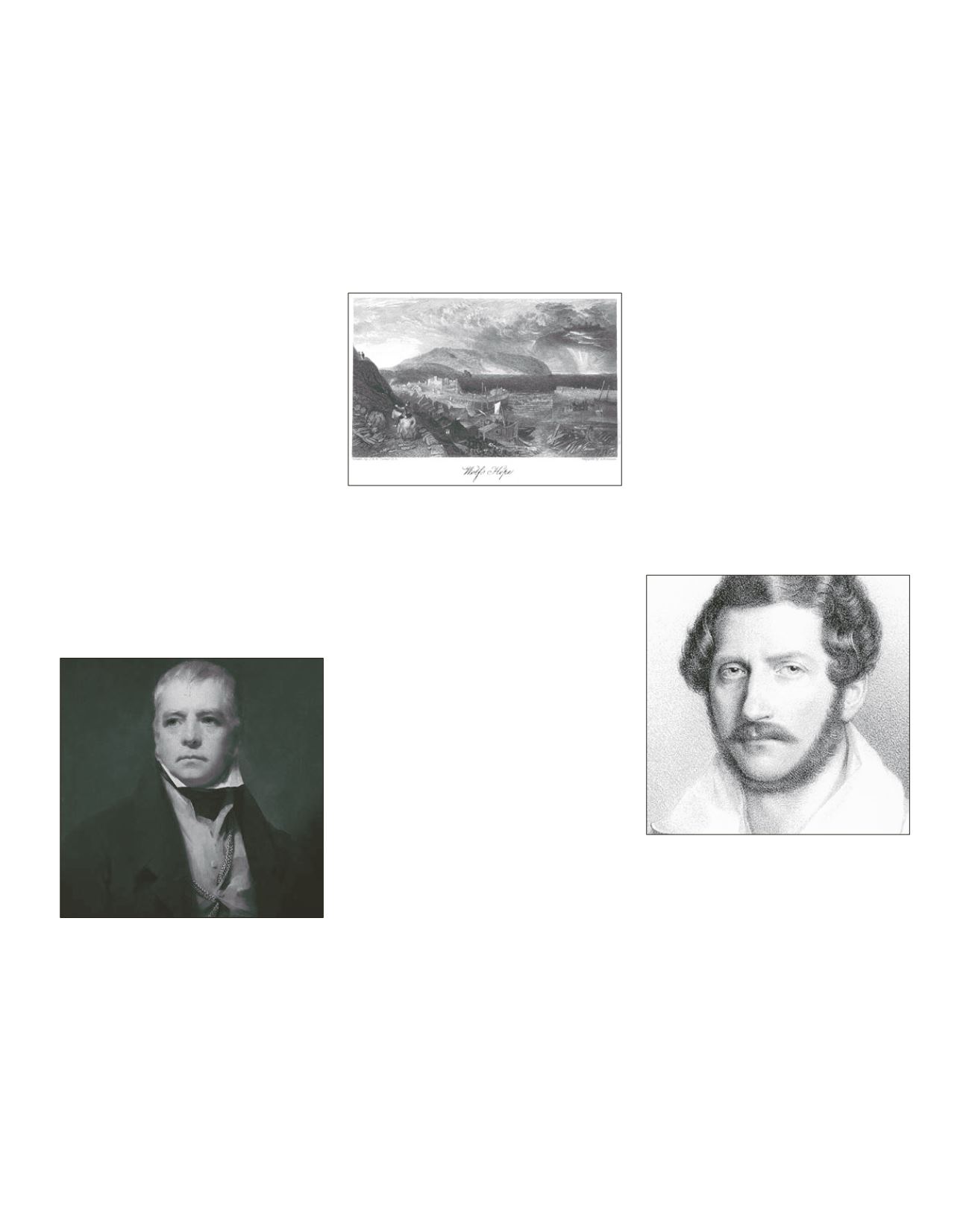
with the weapon, then promises a second arrow
through Gessler’s heart, a threat Tell later car-
ries out. Patriots overrun the governor’s palace,
liberate Switzerland, and sing a jubilant victory
hymn.
Writers o en de ne the Overture to
William Tell
as an orchestral tone poem with several distinct
sections. Morning dawns over the Swiss Alps
to the sounds of a cello consort before a violent
storm erupts. Calm returns momentarily. e -
nal section begins with a fanfare, then continues
with a galloping march (popularized as the
Lone
Ranger
theme) of the victorious Swiss.
In Act One, the annual Shepherd Festival begins
on the shore of Lake Lucerne. As the villagers
prepare cottages for three recently married cou-
ples, William Tell gloomily ponders Switzer-
land’s ongoing oppression by the Austrian forces
occupying its lands. His mood will not lighten,
despite the shermen’s lovely wedding song.
e bridegrooms join their brides in a wedding
dance (
Pas de six
) before an archery competition
begins.
GAETANO DONIZETTI (1797–1848)
Excerpts from
Lucia di Lammermoor
Scored for two utes and piccolo, two oboes, two
clarinets, two bassoons, four horns, two trumpets,
three trombones, timpani, triangle, bass drum,
cymbals, tubular bells, glass harmonica ad libitum,
harp, and strings
Scottish author Sir Walter Scott ( – )
wrote two dozen historical novels, collectively
known as the “Waverley Novels” a er the rst
volume in the series, between
and
. For
years, he denied authorship of these novels is-
sued by the Edinburgh printer James Ballantyne,
only acknowledging that fact in
. At the time
of his death, Scott was editing the novels and
writing new prefaces for a -volume “author’s
From this point, accounts of the incident di er.
Some claim that David attempted to murder
Janet, while others blame the bride for the at-
tack. Still others imagine that Archibald arrived
to take his revenge. Whichever the case, Janet
died less than a fortnight later, on September .
Dunbar remarried (twice), eventually perishing
on March ,
, from injuries sustained in a
fall from a horse.
e forlorn Rutherfurd sur-
vived them both, dying a lifelong bachelor on
March ,
.
is tragic tale, as reimagined by Scott, pos-
sessed numerous theatrical elements that ap-
pealed to Romantic opera composers: political
intrigue, con icts over social class, ill-fated
love, betrayal, and homicide. Five musical set-
tings—each based on a di erent libretto—were
completed or in progress by the time the “au-
thor’s edition” was published: Adolphe Adam’s
Le Caleb de Walter Scott
(Paris,
; libretto by
Achille Dartois and Eugène de Planard), Mi-
chele Carafa’s
Le nozze di Lammermoor
(Paris,
;
libretto by Giuseppe Luigi Balocchi), Luigi
Rieschi’s
La danzata di Lammermoor
(Trieste,
; libretto by Callisto Bassi), Ivar Frederik
Bredal’s
Bruden fra Lammermoor
(Copenhagen,
; libretto by Hans Christian Andersen), and
Alberto Mazzuccato’s
La danzata di Lammer-
moor
, (Padua,
; libretto by Pietro Beltrame).
Within one year of Mazzuccato’s production
in northern Italy, the Neapolitan playwright
and librettist Salvadore Cammarano ( – )
fashioned another adaptation of Scott’s novel
for Gaetano Donizetti’s three-act operatic set-
ting, which opened on September ,
, at
the Teatro San Carlo in Naples.
e action is
tightened, the number of characters reduced,
and their names changed in Cammarano’s ver-
sion: Janet Dalrymple became Lucia Ashton,
Archibald Rutherfurd transformed into Sir Ed-
gardo di Ravenswood, and David Dunbar reap-
peared as Lord Arturo Bucklaw.
edition,” which Robert Cardell released in
with illustrations by J.M.W. Turner.
e Bride
of Lammermoor
(
), the eighth “Waverley
Novel,” followed
e Heart of Midlothian
by one
year and belonged to the third series of “Tales
of My Landlord.” Set in the Lammermuir Hills
of East Lothian, Scotland,
e Bride of Lammer-
moor
is a ctional adaptation of an actual histor-
ical love triangle involving the Dalrymple and
Rutherford families, which Scott had learned as
a youth.
In the late th century, Janet Dalrymple, the
daughter of the Scottish lawyer and Whig James
Dalrymple, First Lord of Stair, pledged her hand
in marriage to Archibald Rutherfurd of Hunt-
hill,
ird Lord of Rutherfurd, a Jacobite from
a family of declining fortunes. Lord and Lady
Stair learned of their engagement and, nding
the match unsuitable, arranged Janet’s marriage
to David Dunbar of Baldoon, First Baronet.
Lady Stair vehemently opposed the marriage to
Rutherfurd, and invoked scripture to support her
objections (Numbers : – ): “But if her father
disallow her in the day that he heareth; not any
of her vows, or of her bonds wherewith she hath
bound her soul, shall stand: and the shall
forgive her, because her father disallowed her.”
e anticipated union with Rutherfurd could
not withstand such biblical arguments, and
he le heartbroken. Janet was forced to marry
Dunbar on August ,
, in the Kirk of Old
Luce near the Dalrymple family castle. Follow-
ing a reception at the castle, the bride and groom
were locked in the bridal chamber, guarded by
one of the groomsmen, who held the only key
to the door. A frightful commotion alarmed the
groomsman, who, upon entering, discovered
Dunbar covered in blood. Janet sat crumpled in
the corner, dressed only in her chemise, “dab-
bled in gore” according to Scott, and mumbling
almost incomprehensibly “Tak’ up your bonny
bridegroom.”
Gaetano Donizetti (ca. 1835)
Sir Walter Scott by Henry Raeburn (1822)
J.M.W. Turner’s
Wolf’s Hope
illustration from the
1833 edition of Sir Walter Scott’s collected works
AUGUST 6 – AUGUST 12, 2018 | RAVINIA MAGAZINE
115








